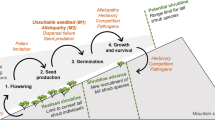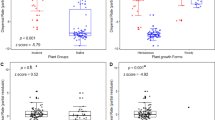Abstract
Identification of processes that shape the spatial structure of invasive species has important implications for understanding population regulation. In invasive Alliaria petiolata we quantified (1) spatial scale of seed dispersal under field conditions, (2) spatial structure of rosette and adult density and (3) the relative importance of environmental filtering, propagule pressure and adult-rosette interactions in shaping rosette and adult density. We conducted a seed dispersal experiment under field conditions; and in a 3 year field survey we measured quadrat-level rosette and adult density, adult seed production and soil moisture and light along transects in three A. petiolata populations at Koffler Scientific Reserve in Southern Ontario, Canada. Propagule pressure was estimated based on quadrat-level seed production and neighbourhood seed production. We found that seed dispersal of A. petiolata followed a lognormal distribution with a mean dispersal distance of 1.82 m, and that spatial structure in both adults (Moran’s I: 0.30–0.56) and rosettes (0.48–0.57) was significant up to 2 m. Propagule pressure and adult-rosette interactions were significant processes associated with rosette density, whereas propagule pressure was the most important process associated with adult density. However, due to the observational nature of the data, it is difficult to determine whether the observed negative association between adult and rosette density is related to competition or to temporal variation in density-dependent seed production. Overall, we conclude that spatially restricted seed dispersal is the most important factor underlying this species’ patchy distributions.



Similar content being viewed by others
References
Anderson RC, Dhillon SS, Kelley TM (1996) Aspects of the ecology of an invasive plant, garlic mustard (Alliaria petiolata), in central Illinois. Restor Ecol 4:181–191
Bauer JT, Anderson RC, Anderson MR (2010) Competitive interactions among first-year and second-year plants of the invasive, biennial garlic mustard (Alliaria petiolata) and native ground layer vegetation. Restor Ecol 18:720–728
Biswas SR, Wagner HH (2012) Landscape contrast: a solution to hidden assumptions in the metacommunity concept? Landsc Ecol 27:621–631
Biswas SR, Wagner HH (2014) A temporal dimension to the stress gradient hypothesis for intraspecific interactions. Oikos. doi:10.111/oik.00878
Biswas SR, Kotanen PM, Kambo D, Wagner HH (2014) Context-dependent patterns, determinants and demographic consequences of herbivory in an invasive species. Biol Invasions. doi:10.1007/s10530-014-0715-0
Bivand R, Altman M, Anselin L, Assunção R, Berke O, Bernat A, Blanchet G, Blankmeyer E, Carvalho M, Christensen B, Chun Y, Dormann C, Dray S, Halbersma R, Krainski E, Legendre P, Lewin-Koh N, Li H, Ma J, Millo G, Mueller W, Ono H, Peres-Neto P, Piras G, Reder M, Tiefelsdorf M, Yu D (2012) spdep: Spatial dependence: weighting schemes, statistics and models. R package version 0.5-46/r430. http://R-Forge.R-project.org/projects/spdep/
Bullock JM, Clarke RT (2000) Long distance seed dispersal by wind: measuring and modelling the tail of the curve. Oecologia 124:506–521
Cavers P, Heagy M, Kokron R (1979) The biology of Canadian weeds. 35. Alliaria petiolata (M. Bieb.) Cavara and Grande. Can J Plant Sci 59:217–229
Clobert J, Danchin E, Dhondt AA, Nichols JD (2001) Dispersal. Oxford University Press, Oxford
Colautti RI, Grigorovich IA, MacIsaac HJ (2006) Propagule pressure: a null model for biological invasions. Biol Invasions 8:1023–1037
Cottenie K (2005) Integrating environmental and spatial processes in ecological community dynamics. Ecol Lett 8:1175–1182
Cruden RW, McClain AM, Shrivastava G (1996) Pollination biology and breeding system of Alliaria petiolata (Brassicaceae). Bull Torrey Bot Club 123:273–280
Dale MRT (1999) Spatial pattern analysis in plant ecology. Cambridge University Press, Cambridge
Dale MRT, Fortin MJ (2005) Spatial analysis: a guide for ecologists. Cambridge University Press, Cambridge
Davis AS, Landis DA, Nuzzo V, Blossey B, Gerber E, Hinz HL (2006) Demographic models inform selection of biocontrol agents for garlic mustard (Alliaria petiolata). Ecol Appl 16:2399–2410
Dormann CF, McPherson J, Araújo MB, Bivand R, Bolliger J, Carl G, Davies RG, Hirzel A, Jetz W, Kissling WD, Kühn I, Ohlemüller R, Peres-Neto P, Reineking B, Schröder B, Schurr FM, Wilson R (2007) Methods to account for spatial autocorrelation in the analysis of distributional species data: a review. Ecography 30:609–628
Dray S, Pellissier R, Couteron P, Fortin MJ, Legendre P, Peres-Neto P, Bellier E, Bivand R, Blanchet FG, Caceres M, Dufour AB, Heegaard E, Jombart T, Munoz F, Oksanen J, Thioulouse J, Wagner HH (2012) Community ecology in the age of multivariate multiscale spatial analysis. Ecol Monogr 82:257–275
Evans JA, Davis AS, Raghu R, Ragavendran A, Landis DA, Schemske DW (2012) The importance of space, time, and stochasticity to the demography and management of Alliaria petiolata. Ecol Appl 22:1497–1511
Fortin M-J, James PMA, MacKenzie A, Melles SJ, Rayfield B (2012) Spatial statistics, spatial regression, and graph theory in ecology. Spat Stat 1:100–109
Gilpin ME, Hanski I (1991) Metapopulation dynamics: empirical and theoretical investigations. Academic press, London
Hewitt JE, Legendre P, McArdle BH, Thrush SF, Bellehumeur C, Lawrie SM (1997) Identifying relationships between adult and juvenile bivalves at different spatial scales. J Exp Mar Biol Ecol 216:77–98
Holt RD, Hoopes MF (2005) Food web dynamics in a metacommunity context. In: Holyoak M, Leibold MA, Holt RD (eds) Metacommunities: spatial dynamics and ecological communities. University of Chicago Press, Chicago, pp 68–93
Jones O, Maillardet R, Robinson A, Borovkova O, Carnie C (2009) Introduction to scientific programming and simulation using R. Taylor and Franchis Group, LLC, London
Jones O, Maillardet R, Robinson A, Borovkova O, Carnie C (2012) spuRs: Functions and Datasets for “Introduction to Scientific Programming and Simulation Using R”. R package version 1.0.5
Legendre P (1993) Spatial autocorrelation: trouble or new paradigm? Ecology 74:1659–1673
Legendre P, Legendre L (1998) Numerical ecology. Elsevier, Amsterdam
Leibold MA, Holyoak M, Mouquet N, Amarasekare P, Chase JM, Hoopes MF, Holt RD, Shurin JB, Law R, Tilman D, Loreau M, Gonzalez A (2004) The metacommunity concept: a framework for multiscale-community ecology. Ecol Lett 7:601–613
Levin SA (1992) The problem of pattern and scale in ecology: the Robert H. MacArthur award lecture. Ecology 73:1943–1967
Levine JM, McEachern AK, Cowan C (2011) Seasonal timing of first rain storms affects rare plant population dynamics. Ecology 92:2236–2247
Lockwood J, Cassey P, Blackburn T (2005) The role of propagule pressure in explaining species invasions. Trends Ecol Evol 20:223–228
Luken JO, Thieret JW (1997) Assessment and management of plant invasions. Springer series on environmental management. Springer, New York, p 117
Malkinson D, Jeltsch F (2007) Intraspecific facilitation: a missing process along increasing stress gradient–insights from simulated shrub populations. Ecography 30:339–348
McCann KS, Rasmussen JB, Umbanhowar J (2005) The dynamics of spatially coupled food webs. Ecol Lett 8:513–523
McIntire EJB, Fajardo A (2009) Beyond description: the active and effective way to infer processes from spatial patterns. Ecology 90:46–56
Meekins JF, McCarthy BC (2001) Effect of environmental variation on the invasive success of a nonindigenous forest herb. Ecol Appl 11:1336–1347
Meekins JF, McCarthy BC (2002) Effect of population density on the demography of an invasive plant (Alliaria petiolata, Brassicaceae) population in a southeastern Ohio forest. Am Midl Nat 147:256–278
Moran PAP (1948) The interpretation of statistical maps. J R Stat Soc B 10:243–251
Nathan R, Muller-Landau HC (2000) Spatial patterns of seed dispersal, their determinants and consequences for recruitment. Trends Ecol Evol 15:278–285
Pielou EC (1960) A single mechanism to account for regular, random and aggregated populations. J Ecol 69:575–584
Powell RD (1990) The role of spatial pattern in the population biology of Centaura diffusa. J Ecol 78:374–388
R Development Core Team (2011) R: A language and environment for statistical computing. R Foundation for Statistical Computing, Viena
Rodgers VL, Stinson KA, Finzi AC (2008) Ready or not, garlic mustard is moving in: Alliaria petiolata as a member of eastern north American forests. Bioscience 58(5):426–436
Schlup B, Wagner HH (2008) Effects of the study design and analysis on the spatial community structure detected by multiscale ordination. J Veg Sci 19:621–632
Seabloom EW, Bjornstad ON, Bolker BM, Reichman OJ (2005) Spatial signature of environmental heterogeneity, dispersal, and competition in successional grasslands. Ecol Monogr 75:199–214
Venables WN, Ripley BD (2002) Modern applied statistics with S, 4th edn. Springer, New York
Wagner HH, Fortin MJ (2005) Spatial analysis of landscapes: concepts and statistics. Ecology 86:1975–1987
Williamson M (1996) Biological invasions. Chapman Hall, London, pp 244
Winterer J, Walsh MC, Poddar M, Brennan JW, Primak SM (2005) Spatial and temporal segregation of juvenile and mature garlic mustard plants (Alliaria petiolata) in a central pensylvania woodland. Am Midl Nat 153:209–216
Acknowledgments
The study was supported by a NSERC discovery grant to HHW. We thank Art Weis for providing the design and offering some of his seed-traps, Daz Kambo, Adrian DiFederico and Zangeetha Perinathan for assisting in field or laboratory works, and Marie-Josée Fortin, Peter Kotanen, Benjamin Gilbert, Mark Vellend, Lindsay Turnbull, Richard Lankau and two anonymous reviewers for comments or discussion on earlier versions of this manuscript. This is a publication of Koffler Scientific Reserve at Jokers Hill.
Author information
Authors and Affiliations
Corresponding author
Electronic supplementary material
Below is the link to the electronic supplementary material.
Rights and permissions
About this article
Cite this article
Biswas, S.R., Wagner, H.H. Spatial structure in invasive Alliaria petiolata reflects restricted seed dispersal. Biol Invasions 17, 3211–3223 (2015). https://doi.org/10.1007/s10530-015-0946-8
Received:
Accepted:
Published:
Issue Date:
DOI: https://doi.org/10.1007/s10530-015-0946-8




